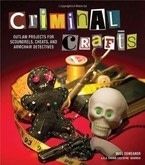
Case The Joint Craft Caddy
Extract from Criminal Crafts • By Shawn Gascoyne-Bowman • Published by Andrews McMeel PublishingAbout
Pack a craft caddy to be prepared for any occasion!
I’m in favor of organized crime. Like a good scout, I’m prepared for any crafting or drinking opportunity, with tools, mixers, and chasers neatly stored and at the ready. Suitcases are the obvious modus operandi, but the criminal crafter deserves a carryall worthy of malcontent.
Did the mob really pack tommy guns in violin cases? Heck, no! The cases are way too small, but it sure looks great in the movies. Here’s how to customize your discarded suitcase or thrift store treasure into a multipurpose vehicle for holding martini glasses, a shaker, bottles of booze, a glue gun, glue sticks, paintbrushes, a craft knife, and anything else Eliot Ness might throw at you.
From Criminal Crafts: Outlaw Projects for Scoundrels, Cheats, and Armchair Detectives by Miss Demeanor a.k.a. Shawn Gascoyne-Bowman
-
 Tashianna S. favorited Case The Joint Craft Caddy
11 Apr 12:25
Tashianna S. favorited Case The Joint Craft Caddy
11 Apr 12:25
-
 mmotse03 favorited Case The Joint Craft Caddy
23 Feb 16:25
mmotse03 favorited Case The Joint Craft Caddy
23 Feb 16:25
-
 Kinhime Dragon favorited Case The Joint Craft Caddy
30 May 18:29
Kinhime Dragon favorited Case The Joint Craft Caddy
30 May 18:29
-
 evasconcellosc favorited Case The Joint Craft Caddy
24 Dec 17:51
evasconcellosc favorited Case The Joint Craft Caddy
24 Dec 17:51
-
 AlterEgo Designs favorited Case The Joint Craft Caddy
19 Nov 19:04
AlterEgo Designs favorited Case The Joint Craft Caddy
19 Nov 19:04
-
 sarah.jones.756412 favorited Case The Joint Craft Caddy
04 Jul 16:47
sarah.jones.756412 favorited Case The Joint Craft Caddy
04 Jul 16:47
-
 isobel.l favorited Case The Joint Craft Caddy
05 Aug 17:28
isobel.l favorited Case The Joint Craft Caddy
05 Aug 17:28
-
 Rebecca L. favorited Case The Joint Craft Caddy
17 Jun 22:50
Rebecca L. favorited Case The Joint Craft Caddy
17 Jun 22:50
-
 MaybeAViking favorited Case The Joint Craft Caddy
13 Jun 12:55
MaybeAViking favorited Case The Joint Craft Caddy
13 Jun 12:55
-
 Raven Beauty favorited Case The Joint Craft Caddy
23 Apr 06:45
Raven Beauty favorited Case The Joint Craft Caddy
23 Apr 06:45
You Will Need
-
 Step 2
Step 2Lay a sheet of newspaper over the inside of the case. (Tape several pieces of newspaper together if you need enough to fit the entire length.) Press the paper down and use a marker to trace a line where the base of the case meets the sides. Take out the paper template and cut along the traced line. Place the template back in the case and check the fit, adjusting as necessary.
-
 Step 4
Step 4Pin the paper template onto the fabric liner and, with fabric chalk or a washable fabric pen, trace a line around the entire shape 1 inch away from the original tracing line. This will give you extra material (a.k.a. selvage) around the edges to attach to the underside of the cardboard insert. Don’t remove the template yet.
-
 Step 7
Step 7If you’d like to add a pocket to the bottom end of the case, place the pocket fabric wrong side up on your work surface, then lay the paper template or cardboard insert on the fabric right side down and trace around just the bottom, leaving a 1-inch allowance around the edges as you did in Step 4. Leave a ½-inch allowance at the top of the pocket so you can fold it over.
-
Step 8
Cut the pocket piece from the fabric and cut 1-inch slits as you did in Step 5.
-
Step 9
Fold the top ½inch of the pocket over, wrong sides together, and glue it down. This will prevent fraying and leave a clean edge on the pocket.
-
Step 10
Place the pocket right side down on your work surface and lay the cardboard on top with the fabric side down.
-
Step 11
Glue the pocket selvage seams down onto the back of the cardboard (over where the main fabric selvages have been glued).
-
Step 12
I use elastic cords and straps to hold down plastic martini glasses and small flasks. Determine where you’d like to place them. I’ve found it helpful to put all my crafting and drinking supplies into the case first and draw a map on my paper template.
-
Step 13
Glue the elastic straps into place, folding over an inch of the excess at each edge and gluing it to the back side of the cardboard.
-
Step 15
Once the new liner is completely assembled it can be hot glued into the base of your case.
Notes: I found my violin case for next to nothing at a shop that sells used instruments, and there are always great deals online. Pretty much anything goes for the fabric lining, from cotton to fake fur. Since I’m a messy crafter and a sloppy drinker, I looked for a pattern where stains wouldn’t be too noticeable. You might want to treat the fabric with Scotchgard or another protectant before mounting it into the case, if you’d like to minimize wear. I also like to buy enough fabric to make a pocket. The elastic cords hold my bottles, glasses, and brushes in place. I used less than a yard of each in my project, but I always buy extra when I’m at the craft store, as I never know when I’ll have to bind something quickly (or gag it, for that matter!).
What to pack: Outfitting your kit is a super treat——I like to have= a sewing kit with scissors, the indispensable glue gun, an extension cord, markers, paints, brushes, maps, train schedules, fake passport, margarita salt, absinthe, lock pick . . . you know, the usual . . .









 1
Stud Earrings »
Miraculous Ladybug Earrings
1
Stud Earrings »
Miraculous Ladybug Earrings
